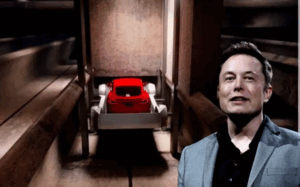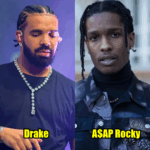In a city synonymous with gridlock and rush-hour agony, tech billionaire Elon Musk is offering a futuristic escape route—literally beneath the surface. His ambitious plan to solve Los Angeles’ decades-old traffic problem involves taking commuters underground through a network of high-speed, low-cost tunnels.

This bold concept is the cornerstone of The Boring Company, Musk’s infrastructure and tunnel construction venture that aims to revolutionize urban transportation as we know it. While skeptics have long questioned the feasibility of digging vast underground systems beneath densely populated areas like LA, Musk has remained resolute: “You have to go 3D to solve traffic. Roads are 2D. Tunnels go under everything. No conflicts.”
So, can this radical vision actually work? And more importantly, will it ever be realized in a city as complex as Los Angeles?
🚗 The Problem: LA’s Traffic Crisis
Los Angeles has long been infamous for its congested freeways, never-ending commute times, and urban sprawl. According to INRIX Global Traffic Scorecard, LA consistently ranks among the worst cities in the U.S. for traffic congestion, with drivers losing an average of 75 to 100 hours per year stuck in traffic.
For years, city planners and politicians have proposed light rail, bus lanes, and congestion pricing—but progress has been slow. Musk’s frustration with LA traffic reportedly reached a tipping point in 2016 when he tweeted:
“Traffic is driving me nuts. Am going to build a tunnel boring machine and just start digging…”
Most took it as a joke. But Musk wasn’t joking.
🛠️ The Boring Company: Tunneling Toward the Future
Soon after that tweet, The Boring Company was born. With a mission to reduce tunneling costs and dramatically accelerate construction times, the company began developing machines and systems designed to make underground transportation viable for cities like LA.
In 2018, Musk unveiled the first proof-of-concept tunnel under Hawthorne, California. Though short and experimental, it gave the world its first glimpse at what he envisioned: a low-cost tunnel network transporting vehicles and passengers at high speed, free from the limitations of traditional roads.
Musk’s tunnels are designed to be narrower and more efficient than conventional subway systems, with Tesla vehicles or electric skates carrying passengers through them at speeds of up to 150 mph.
📍 Los Angeles: The Pilot Project
The flagship proposal involves connecting key LA areas—like Westwood, downtown Los Angeles, and LAX airport—through underground tunnels. Unlike traditional public transportation, Musk’s system would offer point-to-point, nonstop travel, dramatically reducing commute times.
For example:
A trip from LAX to downtown LA could take just 8–10 minutes, compared to 45–90 minutes by car in traffic.
Routes could also connect Dodger Stadium, Santa Monica, and major business districts.
The company has pitched this not as a replacement for public transit, but as a supplementary system for those seeking a faster, more flexible option.
💬 Mixed Reactions: Innovation or Illusion?
Musk’s tunneling vision has drawn a mix of excitement and criticism.
Supporters say it’s exactly the kind of disruptive thinking LA needs. They praise Musk’s ambition, especially given The Boring Company’s rapid development of more efficient boring machines—reportedly capable of digging 14 times faster than current technology at a fraction of the cost.
But critics warn that the plan may be overly simplistic. Tunneling in earthquake-prone, bureaucratic Los Angeles poses logistical and regulatory nightmares. Others argue that investing in improved public transportation would yield broader benefits for more people, not just those who can afford to ride in Teslas.
Still, the potential remains intriguing. Even LA Mayor Eric Garcetti has expressed tentative support, saying in 2021:
“We need every creative solution we can get. If Elon wants to dig tunnels, let’s see what’s possible.”
🌐 Where Things Stand Now
The Boring Company has received preliminary approvals to explore multiple projects in California and Nevada. One of its most successful implementations so far is the Vegas Loop, a 70+ station network currently under construction in Las Vegas that already operates small sections during major conferences.
That success is being watched closely by LA city officials. If it scales well in Vegas, LA could be next.
Meanwhile, Musk continues to push forward—fine-tuning tunnel designs, reducing costs, and promising that his system won’t just move people faster—it will transform how cities function.
🚀 Final Thoughts: A Vision Worth Digging For?
While the future of subterranean travel in Los Angeles is far from certain, one thing is clear: Elon Musk is serious about building it. In a city defined by car culture, sky-high emissions, and maddening traffic, a network of silent, high-speed tunnels could change how Angelenos live, work, and move.
Musk’s tunnel dream may still be in its early stages, but as with SpaceX and Tesla before it, the impossible often begins with a simple idea—and a refusal to accept the status quo.
Whether LA is ready to go underground with Musk remains to be seen. But if he succeeds, it won’t just be traffic that disappears—it’ll be limits on how we imagine cities of the future.
News
Matt Lauer’s “$150M Revenge Rampage”: “Due Process Denied” Lawsuit Targets NBC’s “Scandal Sham” – The “Rewrite My Story” W:ar Is On!
Matt Lauer, the fallen king of morning television whose 2017 ouster from Today amid a storm of sexual misconduct allegations…
Yamiche Alcindor’s “Light After Darkness”: IVF Son Yrie to Natural Miracle Baby – The Sheinelle Jones Lesson That’s Healing Hearts!
Yamiche Alcindor, the trailblazing NBC News White House correspondent whose incisive reporting has illuminated the corridors of power for a…
David Muir’s “Armor Crack” Agony: Tearful Strahan Tribute Turns GMA Studio to Sobs – The Bond Breaking Hearts!
The Good Morning America studio, long a sanctuary of sunrise smiles and steadfast solidarity for 2.5 million daily viewers, was…
GMA’s “Unbreakable Trio” Broken: Strahan, Roberts & Stephanopoulos’ Tearful Colleague Crisis – The “Stunned” News Crushing Mornings!
The Good Morning America studio, long a bastion of bright banter and buoyant beginnings for 2.5 million daily viewers, was…
Hoda Kotb’s “Hardest Thing” Bombshell: “It’s Time to Leave” – The Tearful NBC Exit That’s Shattering Morning TV Fans!
Hoda Kotb, the radiant Today co-anchor whose infectious energy and empathetic edge have illuminated NBC mornings for 17 years, has…
Michael Strahan’s Isabella N:ightmare: “Nervous Every Scan” – The C:ancer Comeback Fears Crushing GMA’s Golden Boy!
Michael Strahan, the beaming Good Morning Britain anchor whose Super Bowl swagger once sacked quarterbacks, has laid bare a father’s…
End of content
No more pages to load












